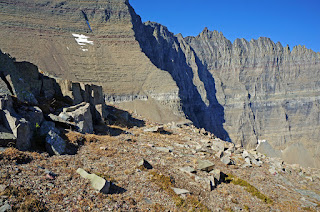

On the shore of McDonald Lake, a lodge has stood since
1895. When the area became a national
park in 1910, the lodge kept right on operating, and has ever since. It closes for the season on the first of
October, turning away plenty of people who love this time of year. But profits are lower, so why bother. Let them come in the summer when demand
doubles the price. Of course, pressure
on the environment is greater then, but taxes pay for that.
Here by the quiet lake, it’s hard to imagine a glacier two
thousand feet thick, melting ten thousand years ago, and leaving moraines that dammed
McDonald Creek, making a lake 470 feet deep.

From here, I headed into the woods, and though the forest is
dense, occasionally I could look down on McDonald Lake. From where I took these pictures, we are
still below the top of that great Pleistocene
glacier.
Now we are far above the lake.
Ttrees are thinning and becoming smaller, but the yellow aspens of fall don’t
seem to get elevation sickness.
Moss hangs from the trees like it does in Georgia, but it’s a
different kind of moss. Interesting that
the idea of moss survives in such diverse places, like laws of nature do.
Turning ahead now and looking up canyon, away from McDonald
Lake, the climb steepens, and walls press in on both sides, and still the aspens
carry on.
Nothing disturbs the silence here when wind is calm and the
birds are relaxing, except perhaps Kathaabela flying to Chicago. There’s a poem in that rumble overhead, I sense
it.
The conifers are lean and strong up here; they know how to
live where snow comes deep and wind strong.
Another glacier-formed lake, much higher than McDonald Lake
and formed by a smaller glacier, which might have been a branch of the same
glacier, back when ice covered most of these mountains. Snyder Lake lies today in still air,
cloistered in a cirque against a high ridge.
My Enabler
(haibun by Sharon Hawley)

I remember the survivor’s expression on your face. Gallon canteen strapped over your shoulder,
as you followed me up the trail. You had brought a wild girl into the world,
and you would raise her. This, your way of
training, socializing without punishment.
You were hurt by those times I went alone into the mountains
without telling anyone, even stayed overnight.
I worried you and probably caused your early heart attack.
Your determined jaw as you trudged up the trail. I think how it must have been during the
Depression on the American River. You
left home and panned gold, sent enough money back to save your family. Now your determination is saving me so I can
hike again.
I was hiking alone in bear country again today, obsessed with
seeing as much of Glacier Park as I can before winter. You gave me the means to enjoy the therapy
and authority of hiking alone where instructions say never hike alone. You see, Daddy, nobody really recovers from
anything; we learn to live with it. You
were my enabler.
Memories condense like sedimentary layers in my brain. Having you along now is as much a part of the
journey as the shuffle of my boots along the trail and the hard blue sky when
the sun comes out.
when passion goes awry
sometimes
one understands

 Yesterday, after several days of rain, it snowed. Today, the sun brightened on a new white
world. I parked the jeep at a trailhead and walked
into a new creation, where never a human had trod. I walked for hours and returned to the jeep
following the only boot prints—mine.
Yesterday, after several days of rain, it snowed. Today, the sun brightened on a new white
world. I parked the jeep at a trailhead and walked
into a new creation, where never a human had trod. I walked for hours and returned to the jeep
following the only boot prints—mine.




 I come to the shore of
Stanton Lake in the Great Bear Wilderness and wonder why, in all these
hikes, I have seen no bears, neither grizzly nor black bears, where they are
reportedly quite populous. I have not
even seen a bear footprint, nor their scratching on trees, nor their
droppings. I often feel oblivious to
something unseen around me, and this is only one thing.
I come to the shore of
Stanton Lake in the Great Bear Wilderness and wonder why, in all these
hikes, I have seen no bears, neither grizzly nor black bears, where they are
reportedly quite populous. I have not
even seen a bear footprint, nor their scratching on trees, nor their
droppings. I often feel oblivious to
something unseen around me, and this is only one thing. 

















































